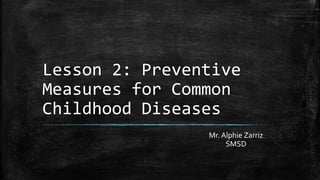
Lesson 2 preventive measures for common childhood diseases
- 1. Lesson 2: Preventive Measures for Common Childhood Diseases Mr. Alphie Zarriz SMSD
- 2. The importance of Good Personal Hygiene Maintaining personal hygiene is essential for various personal, social, health, and psychological reasons. Personal hygiene enables you to avoid the development of infections, illness, and body odors. The following are examples of good personal hygiene. 1. Wash your body often. Take a bath every day to remove the bacteria, dust, and dirt that stick on your skin. Wash your body with soap and water. 2. Brush your teeth every after meal to get rid of gum disease and tooth decay. 3. Wash your hands with soap after going to the toilet, before preparing your food, and during normal activities to avoid disease-causing germs that may get on your hands and under your nails.
- 3. 4. Change your clothes every day. Dirty clothes must be washed with soap and water. Refrain from borrowing clothes and other personal things such as towel, shirt, underwear, and even socks and shoes from other people. 5. Cover your nose when sneezing and coughing to avoid the spread of diseases.
- 4. Environmental Sanitation Cleanliness is one of the essential practices for a clean and healthy environment. It is necessary that each individual must learn about cleanliness, hygiene, sanitation, and various diseases that are caried out through unhealthy surroundings. You can take part in environmental sanitation by doing the following. 1. Keep your surroundings clean and dispose of garbage properly. 2. Protect the water supply from pollution. Check the pipes, especially after a storm, to avoid water contamination. 3. Avoid littering in public places. Follow trash segregation at all times. Separate the the biodegradable from the non-biodegrable materials. 4. Refrain from spitting on the road and avoid urinating in public areas.
- 5. Building up One’s Body Resistance Eating a proper nutritious meal provides several health benefits that can keep you physically and mentally fit. Proper nutrition consists of food rich in protein, carbohydrates, and fat. One must eat a balanced diet meal composed of go, grow, and glow foods. Sleeping and resting make you feel better. A child like you must sleep at least 8 hours a day. Getting enough sleep helps your brain function properly. It enhances your learning and problem-solving skills. Sleep helps in healing and repairing your heart and blood vessels. Regular physical activity is one of the most important thing that you can do make your body healthy. Regular exercise controls weight; reduce heart disease, diabetes, and cancer; and strengthens bones and muscles.
- 6. Regular Health and Dental Checkup Regular health exams and tests can help detect health problems before they appear. Early detection of diseases may lead to better chances of treatment and cure. By having the right health services, medical exams, screening and treatments, you are taking steps to have a longer and healthier life. Regular dental visits are necessary because they keep your gums and teeth healthy. During a regular dental checkup, the dentist checks your teeth for cavities to see if there are plaque or tartar. Plaque is a clear sticky layer of bacteria of the surface of the teeth. If not removed, it may harden and becomes tartar. Aside from this, the dentist also performs a thorough cleaning of your teeth. This is done by brushing and flossing the teeth to remove tartar.
- 7. Immunizations (Vaccines) Vaccines are used to boost your immune system and to prevent serious and life- threatening diseases. Vaccines help your body to defend itself against invading germs, bacteria, and viruses. Vaccines work by exposing your body to a very small and safe amount of bacteria that have been weakened or killed. This helps your immune system recognize and attack the infection once your body is used to it. As a result, you will not become ill or infected.
- 8. Four types of vaccines Virus-like vaccines are made up of the weakened form of the virus. Examples of this kind of vaccines are measles vaccine, mumps vaccine, rubella vaccine, and chicken pox vaccine. Killed (inactive) vaccines are created from the protein or other particles taken from bacteria or virus. Influenza (flu) vaccine is an example of a killed or inactive vaccine. Toxoid vaccines are made from a toxin or chemical produced by a bacteria or virus. They protect the body from the harmful effects of the infection. Diphtheria or tetanus vaccines are good examples of this type of vaccine. Biosynthetic vaccines are composed of man-made substances that resemble the virus or bacteria. Hib (haemophilus influenza type B) conjugate vaccine is an example of biosynthetic vaccine.